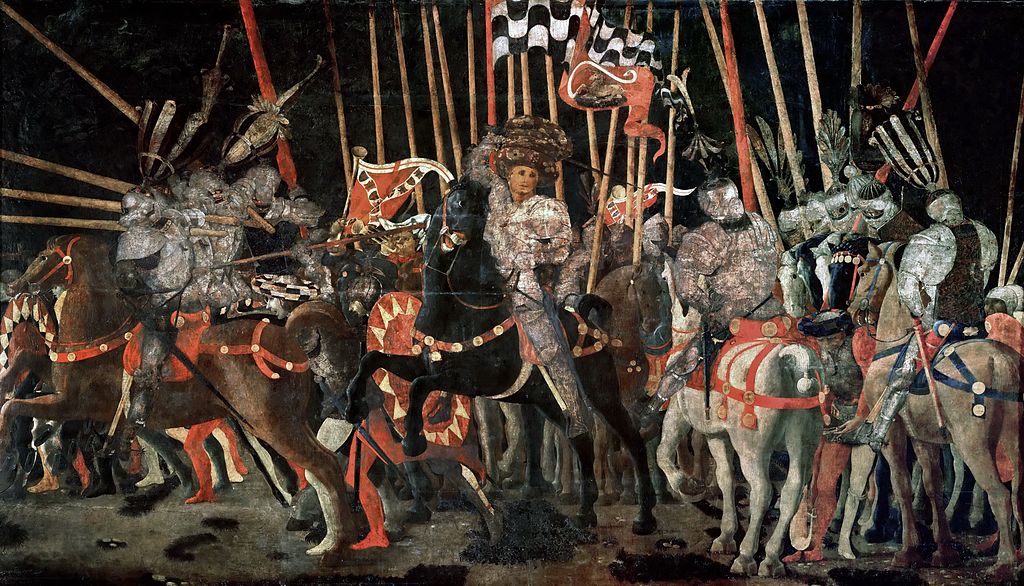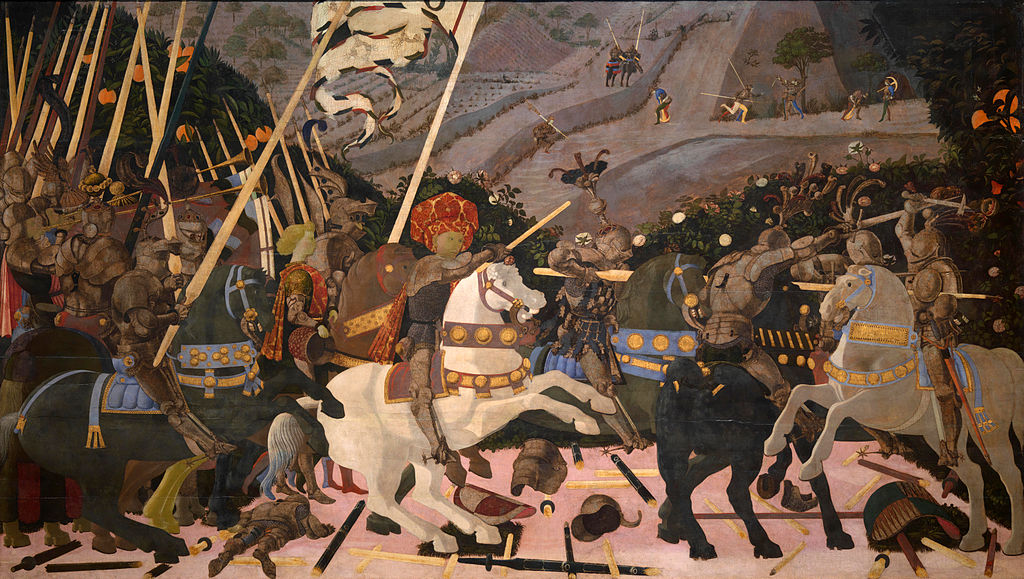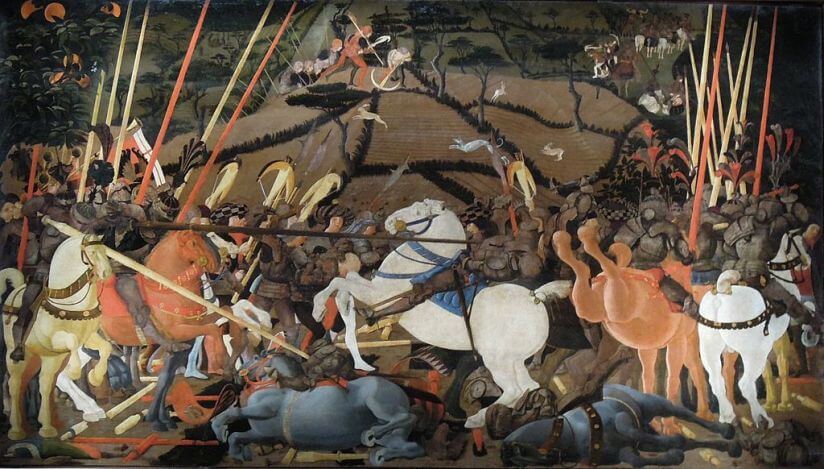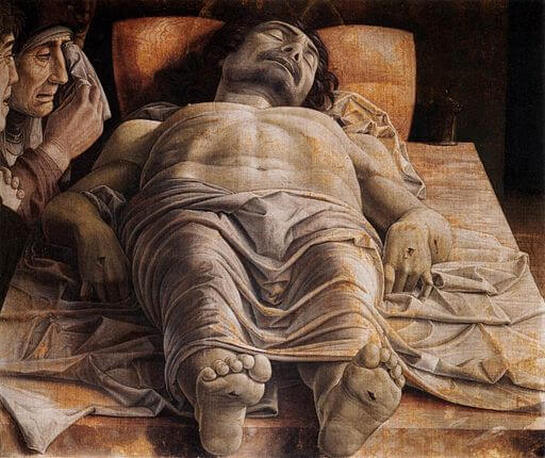|
Where? First floor, room 708 of the Denon wing in the Louvre
When? Between 1435 and 1460. The dating of this painting has been the subject of much debate, but most critics believe it was painted between 1435 and 1440. Commissioned by? Lionardo Bartolini Salimbeni, a rich Florentine man who had a strong commercial interest in the battle of San Romano. What do you see? This painting shows a scene from the battle of San Romano on June 1, 1432. This battle was fought between the Republic of Florence and the Republic of Lucca with its allies. The central figure is the Florentine general Micheletto Attendolo (also known as Michele Attendolo or Micheletto da Cotignola). There are several more figures and horses depicted in the foreground, each with their own role, creating a sense of movement in the painting. The soldiers on the right are waiting to participate in the battle. Micheletto on the black horse is giving the command to start the attack with his right hand, in which he is holding a sword. Unlike the other soldiers, Micheletto is wearing a big hat to signal that he is the general. Behind Micheletto, on the left, you can see two men holding a trumpet to communicate Micheletto’s commands to the Florentine army. The soldiers on the left are starting the attack with their lances in attacking position. In the background, you can see a forest of soldiers, horse legs, and lances conveying the chaos of a battle. Uccello used foreshortening to include perspective in this painting to make it look like a three-dimensional scene. Backstory: The battle of San Romano (a small place in Italy, near Lucca) was part of the war between the Republic of Florence and the Republic of Lucca with its allies from Genoa, Milan, and Siena. An important element of the war was about who would get access to the port of Pisa for trade. The battle of San Romano took place on June 1, 1432, and lasted less than a day. This battle was only a relatively minor battle, but the Florentines remembered it as a turning point in the war. This painting commemorates the Florentine victory in this battle, though Sienese sources disagree with this conclusion. The battle was started by Florentine general Niccoló Tolentino (who is at the center of the National Gallery version of this battle) who got attacked after he was separated from most of his army while exploring the area. Tolentino and his small group of soldiers fought a brave fight and did not give up until another Florentine general, Micheletto Attendolo, arrived at the battle scene with reinforcements. Attendolo and his army helped Florence to win this battle. The war dragged on for another year without a clear winner, and in the end the war was settled through negotiations. Other versions of this painting? This painting is a part of a triptych (a work of art divided into three parts) made by Uccello. The three paintings represent different moments in the battle of San Romano. There are two alternative explanations about the order of the paintings. The simple explanation is that the three paintings represent the morning of the fight (the version in the National Gallery in London), the afternoon (the Uffizi version), and the evening (the current version). However, the question is whether the current version represents the evening or whether as the paint in the background has deteriorated over time. A more popular alternative is that the National Gallery version represents the beginning of the battle with Niccoló da Tolentino. The current version represents the arrival of Micheletto Attendolo and his army, and the Uffizi version shows the last episode where Bernardino della Ciarda from the opposing army has been unhorsed.
Who is Uccello? Paolo Uccello (1397-1475) was born as Paolo di Dono in Pratovecchio in Tuscany. In his teenage years, he was an apprentice of Lorenzo Ghiberti and later he got influenced by contemporaries such as Donatello, Brunelleschi, and Masaccio. He was named Uccello, which is Italian for ‘bird’, because he liked to paint birds. He developed strong scientific interests and was very interested in representing perspective in paintings, something that he and contemporary artists just introduced to painting.
The appropriate use of linear perspective was often more important for Uccello than what the painting should represent. In his paintings, he combines elements of the older Gothic tradition (the decorative parts) and the newer Renaissance movement (which introduced depth and perspective). Linear Perspective? Linear perspective was developed around 1420 by Brunelleschi. It was a completely new approach to represent space in paintings. A simple explanation of linear perspective is that the size of objects becomes smaller the further away they are from the observer. Paintings with perspective have one or multiple vanishing points which help the painter to create perspective. Foreshortening is a specific form of perspective in which an illusionary trick is used to provide the idea of depth. A great example is when someone wants to paint a picture of a person laying with his feet towards you. To create the idea of depth, the painter will paint the feet of the person bigger than his head. The Lamentation of Christ by Mantegna is a great example of a painting with foreshortening. Note that the linear perspective in Uccello’s paintings is not perfect, but it did help to create depth in two-dimensional paintings. His work served as an inspiration for many artists in the next generations who perfected his ideas about linear perspective in paintings.
Fun fact: This painting has deteriorated over time. For example, the background is much darker than initially painted by Uccello. Another area of strong deterioration are the armors in this painting. Uccello used gold and silver leaf for various parts of the painting. The gold leaf, which you can see on the decorations of the horses’ bridles, has remained in good condition over time. However, the silver leaf, mainly found on the armors of the soldiers, has oxydized over time and now looks more like dull grey or almost black.
Uccello was an apprentice of the goldsmith Lorenzo Ghiberti in his teenage years and was thus very familiar with the application of silver and gold leaf. Imagine this painting if the silver was still blinking in its old glory...
Written by Eelco Kappe
References:
0 Comments
Leave a Reply. |
Categories
All
|
- Home
- Blog
-
Museums
- Alte Pinakothek
- Art Institute of Chicago
- Baltimore Museum of Art
- Barber Institute of Fine Arts
- Bargello
- Barnes Foundation
- British Museum
- Church of Sant’Anastasia
- Cleveland Museum of Art
- Courtauld Institute of Art
- Detroit Institute of Arts
- Frans Hals Museum
- Galleria Borghese
- Gallerie dell'Accademia
- Getty Museum
- Guggenheim
- Hermitage Museum
- Kunsthistorisches Museum
- Kunstmuseum Basel
- Legion of Honor Museum
- Louvre
- Mauritshuis
- Metropolitan Museum of Art
- Musee d’Orsay
- Museum of Fine Arts in Boston
- Museum of Modern Art
- National Gallery in London
- National Gallery of Art
- National Museum in Poznań
- Norton Simon Museum
- Ny Carlsberg Glyptotek
- Palace of Versailles
- Palazzo Pitti
- Palazzo Vecchio
- Petit Palais
- Philadelphia Museum of Art
- Prado
- Pushkin Museum
- Ravenna Art Museum
- Rijksmuseum
- San Diego Museum of Art
- Santa Maria delle Grazie
- St. Peter's Basilica
- Städel Museum
- Statens Museum for Kunst
- Tate Britain
- Tate Modern
- Timken Museum of Art
- Uffizi
- Vatican Museums
- Wallace Collection
-
Artists
- Altdorfer
- Anguissola
- Berlin Painter
- Bosch
- Botticelli
- Boucher
- Bronzino
- Bruegel the Elder
- Brunelleschi
- Cabanel
- Caillebotte
- Canova
- Caravaggio
- Carpeaux
- Cezanne
- Cimabue
- David
- Degas
- Delacroix
- De Maria
- Donatello
- El Greco
- Fontana
- Fra Angelico
- Fragonard
- Gauguin
- Gentileschi
- Gericault
- Gonzalez-Torres
- Goya
- Hals
- Hogarth
- Hokusai
- Ingres
- Leonardo da Vinci
- Lippi, Filippo
- Longhi, Barbara
- Lorrain
- Makovsky
- Manet
- Massys
- Matisse
- Merian
- Michelangelo
- Mochi
- Modigliani
- Monet
- Panini
- Parmigianino
- Perugino
- Picasso
- Pisanello
- Raphael
- Rembrandt
- Renoir
- Reynolds
- Rivera
- Rodin
- Rubens
- Scultori
- Seurat
- Steen
- Tintoretto
- Titian
- Toulouse-Lautrec
- Turner
- Uccello
- Van der Weyden
- Van Dyck
- Van Eyck
- Van Gogh
- Van Hemessen
- Vasari
- Velazquez
- Vermeer
- Veronese
- Vigée Le Brun
-
Locations
- Books
- About Us




